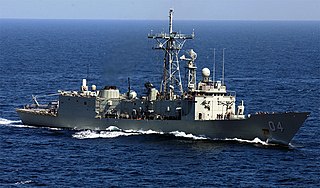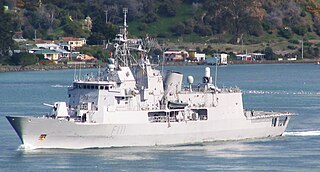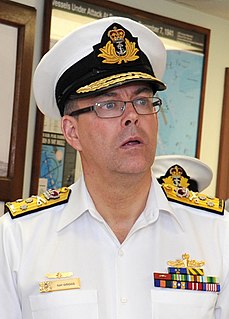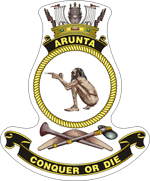
HMAS Darwin, named for the capital city of the Northern Territory, was an Adelaide-class guided-missile frigate, formerly in service with the Royal Australian Navy (RAN). One of four ships ordered from the United States, Darwin entered service in 1984. During her career, she has operated in the Persian Gulf, as part of the INTERFET peacekeeping taskforce, and off the Solomon Islands. The frigate underwent a major upgrade during 2007 and 2008. She was decommissioned on 9 December 2017 and was supposed to be scuttled as a dive wreck in Tasmania, but the deal was pulled by the Tasmanian Government and her fate remains uncertain.

HMAS Newcastle, named for the city of Newcastle, New South Wales, the largest provincial city in Australia, was an Adelaide-class guided-missile frigate. The last ship of the class to be constructed, Newcastle entered service with the Royal Australian Navy in 1993. During her career, the frigate has operated as part of the INTERFET peacekeeping taskforce, served in the Persian Gulf, and responded to the 2006 Fijian coup d'état. The frigate was decommissioned on 30 June 2019 and transferred to the Chilean Navy on 15 April 2020 and renamed as Capitán Prat.

The Royal New Zealand Navy is the maritime arm of the New Zealand Defence Force. The fleet currently consists of nine ships. The Navy had its origins in the Naval Defence Act 1913, and the subsequent purchase of the cruiser HMS Philomel, which by 1921 had been moored in Auckland as a training ship. A slow buildup occurred during the Interwar period, and then perhaps the infant Navy's finest hour occurred soon after the beginning of World War II when HMS Achilles fought alongside two other Royal Navy cruisers at the Battle of the River Plate in December 1939.

The Anzac class is a ship class of ten frigates; eight operated by the Royal Australian Navy (RAN) and two operated by the Royal New Zealand Navy (RNZN). During the 1980s, the RAN began plans to replace the River-class destroyer escorts with a mid-capability patrol frigate and settled on the idea of modifying a proven German design for Australian conditions. Around the same time, the RNZN was seeking to replace their Leander-class frigates while maintaining blue-water capabilities. A souring of relations between New Zealand and the United States of America in relation to New Zealand's nuclear-free zone and the ANZUS security treaty prompted New Zealand to seek improved ties with other nations, particularly Australia. As both nations were seeking warships of similar capabilities, the decision was made in 1987 to collaborate on their acquisition. The project name is taken from the Australian and New Zealand Army Corps of the First World War.

HMAS Parramatta is an Anzac-class frigate of the Royal Australian Navy (RAN). One of ten warships built for the RAN and Royal New Zealand Navy (RNZN) based on the MEKO 200 design, Parramatta was laid down in 1999, launched in 2003, and commissioned into the RAN in 2003. During her career, the frigate has been deployed to the Middle East on several occasions. In early 2015, Parramatta was docked to undergo the Anti-Ship Missile Defence (ASMD) upgrade. She completed these upgrades in April 2016.

HMAS Stuart is an Anzac-class frigate of the Royal Australian Navy (RAN). She was built at Williamstown in Victoria, and commissioned into the RAN in 2002. The frigate is operational as of 2021.

HMAS Sydney was an Adelaide-class guided-missile frigate of the Royal Australian Navy (RAN). The frigate was one of six modified Oliver Hazard Perry-class frigates ordered from 1977 onwards, and the third of four to be constructed in the United States of America. Laid down and launched in 1980, Sydney was named for the capital city of New South Wales, and commissioned into the RAN in 1983.

HMAS Anzac is the lead ship of the Anzac-class frigates in use with the Royal Australian Navy (RAN) and the Royal New Zealand Navy (RNZN). Entering Australian service in 1996, the frigate operated as part of the INTERFET peacekeeping taskforce in 1999. In 2003, she was involved in the Battle of Al Faw, and became the first RAN ship to fire in anger since the Vietnam War. The ship is operational as of 2021.

HMNZS Te Kaha (F77) is one of ten Anzac-class frigates, and one of two serving in the Royal New Zealand Navy (RNZN). The name Te Kaha is Māori, meaning 'fighting prowess' or 'strength'.

HMAS Perth is an Anzac-class frigate of the Royal Australian Navy (RAN). The last ship of the class to be completed, she was built by Tenix Defence and commissioned into the RAN in 2006. In 2007, Perth became the first major warship of the RAN to be commanded by a woman. During 2010 and 2011, the frigate was used as the testbed for a major upgrade to the Anzac class' ability to defend themselves from anti-ship missiles.

HMAS Toowoomba is the seventh Anzac-class frigate of the Royal Australian Navy (RAN). She was laid down in 2002 by Tenix Defence and commissioned in 2005.

HMAS Warramunga is an Anzac-class frigate of the Royal Australian Navy (RAN). One of ten frigates built for the Australian and New Zealand navies, Warramunga was laid down by Tenix Defence in 1997 and commissioned in 2001. During her career, the frigate has operated in the Persian Gulf as part of Operation Catalyst, and undertaken anti-piracy operations off Somalia. Warramunga underwent the Anti-Ship Missile Defence (ASMD) upgrade during 2014. She is active as of October 2022.

HMAS Ballarat is an Anzac-class frigate of the Royal Australian Navy (RAN). The frigate was laid down in 2000 and commissioned into the RAN in mid-2004. Since entering service, Ballarat has been involved in border protection as part of Operation Relex II, was deployed to the Gulf for Operation Catalyst, and was one of the two ships involved in the Operation Northern Trident 2009 round-the-world voyage. Ballarat has undergone the Anti-Ship Missile Defence (ASMD) upgrade, completing in 2015.

HMAS Melbourne was an Adelaide-class guided-missile frigate of the Royal Australian Navy, which entered service in 1992. Melbourne has been deployed to the Persian Gulf on several occasions, and served as part of the INTERFET peacekeeping taskforce in 2000. On 26 October 2019, Melbourne was decommissioned from the RAN, subsequently being transferred to Chile. The ship was commissioned into the Chilean Navy as Almirante Latorre on 15 April 2020.

HMNZS Te Mana (F111) is one of ten Anzac-class frigates and one of two serving in the Royal New Zealand Navy (RNZN). The name Te Mana is Māori, approximately translating as 'status' or 'authority'. The ship was laid down under the joint Anzac project by Tenix Defence at Williamstown, Victoria in 1996, launched in 1997, and commissioned into the RNZN in 1999.

The Adelaide class was a ship class of six guided missile frigates constructed in Australia and the United States of America for service in the Royal Australian Navy. The class was based on the United States Navy's Oliver Hazard Perry-class frigates, but modified for Australian requirements. The first four vessels were built in the United States, with the final two being constructed in Australia.

Project Protector was a Royal New Zealand Navy (RNZN) procurement project that was undertaken during the 2000s. At the start of the decade, the New Zealand government tasked the New Zealand Defence Force to develop an equal combat, peacekeeping, and disaster relief capability, in which the RNZN was to focus on conducting sealift operations and patrols of the Economic Exclusion Zone. A series of reviews found that the RNZN was lacking in these capabilities, and Project Protector was established to acquire three new ship types: a single multi-role sealift ship, two offshore patrol vessels, and four inshore patrol vessels. After a two-year information-gathering and tender process, an Australian company, Tenix Defence, was selected as the primary contractor.

HMNZS Canterbury (F421) was one of two broad beam Leander-class frigates operated by the Royal New Zealand Navy (RNZN) from 1971 to 2005. She was built in Scotland and launched in 1970. Commissioned in 1971, Canterbury saw operational service in much of Australasia and other regions like the Persian Gulf. She undertook operations such as supporting UN sanctions against Iraq and peace-keeping in East Timor. With her sister ship HMNZS Waikato she relieved the Royal Navy frigate HMS Amazon in the Indian Ocean during the Falklands War. Early in HMNZS Canterbury's career, in 1973, she relieved the frigate HMNZS Otago, as part of a unique, Anzac, naval operation or exercise at Moruroa during anti-nuclear protests, supported by a large RAN tanker, providing fuel and a large platform for Australian media. This was due to F 421 being a more modern RNZN frigate, with then current Rn surveillance radar and ESM and a more effectively insulated frigate from nuclear fallout, with the Improved Broad Beam Leander steam plant, for example, being remote controlled and capable of unmanned operation and therefore the ship provided a more effective sealed citadel for operations in areas of nuclear explosions.

The Kaman SH-2G Super Seasprite is an American ship-based helicopter with anti-submarine, anti-surface threat capability, including over-the-horizon targeting. This aircraft extends and increases shipboard sensor and weapon capabilities against several types of enemy threats, including submarines of all types, surface ships, and patrol craft that may be armed with anti-ship missiles. It was originally developed for the United States Navy in 1980s as a reengined version of the older Kaman SH-2 Seasprite.

Vice Admiral Raymond James Griggs, is an Australian senior public servant and a former senior officer in the Royal Australian Navy. He served as Chief of Navy from June 2011 to June 2014, before being appointed Vice Chief of the Defence Force until his transfer to the reserve in July 2018.





















